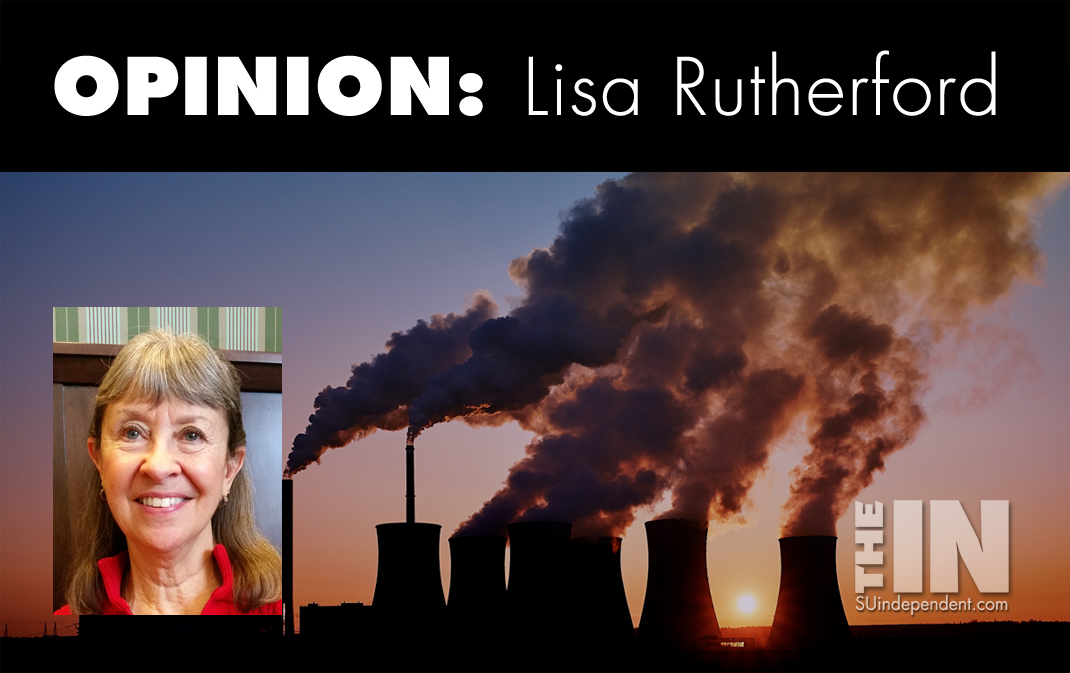
U.S. Losing Ground In Fighting Climate Change
– By Lisa Rutherford –
For those who don’t believe in climate change and don’t believe that the U.S. should spend the money needed to deal with the problems climate change is creating, consider this. Back in 2012 military leaders and corporate leaders advised that changes were needed to head off looming problems. We are witnessing those problems now, and it will just get worse without serious action. We have wasted years with political wrangling. It’s time for the U.S. to get in gear.
So, why is the U.S. losing ground? Delaying the transition to a cleaner energy future will cost the U.S. billions of dollars according to Energy Innovation, a policy group. And, if the U.S. drags its feet on this issue we will lose influence in the world as others make headway. We have what many consider the highest standard of living but with that comes much waste. Are Americans so selfish as to not be willing to play fairly and work for a better future for all?
There are some good signs. Car manufacturers including Ford, GM, and Jaguar, to name a few, are getting on board the electric car bandwagon. But that will not be enough. Will the U.S. be left in the dust – specifically “coal” dust? Coal plants have been closing across the U.S., but many are still in operation with companies not moving fast enough to decommission them. Certainly not fast enough to help avoid the worst effects of climate change. The Biden administration plans to boost the figure used to assess societal damage or the “social cost of carbon” from greenhouse gas pollution to $51 per ton of carbon dioxide and plans a more thorough analysis that could push it as high as $125 per ton.
President Biden is not the only one taking action. Individual states such as New York, Colorado, Minnesota, Illinois, Maine, and Virginia are developing plans to help deal with the costs of carbon. And more than half of the states have some sort of clean-energy mandate. While many states are acting on the issue, some politically-red coastal states that have the most to lose are not engaging. Their addiction to the fossil fuel industry that supports their economies makes them blind to opportunities for new, clean, well-paying jobs. But even New Mexico that has relied on fossil fuel and is a big player in oil shale in their eastern Permian basin has a new vision. Although more than half of onshore oil production on federal land occurs in New Mexico, and President Biden’s moratorium on leasing could cost the state 62,000 jobs, New Mexico is still preparing for a new energy future. A New Mexico state representative with relatives in the industry is looking ahead and sponsoring a bill to transition workers.
This challenge may sound daunting to the casual reader but climate change is already costing us—you, me and others—and other countries billions each year according to the well-respected though slightly left-of-center publication “The Economist.” These costs are hidden by not being fully accounted for. Even the middle-of-the-political road Wall Street Journal reports that the SEC will be reviewing how companies disclose climate change risks since investors are more concerned than ever before. Climate change resulting in rising sea levels is not just affecting pricey coastal areas. The effects of billion-dollar weather and climate disasters are being experienced across our country. The weather devastation in February in Texas showed that America needs both a more reliable grid and cleaner one. It was not renewables that caused the problem but an out-dated grid.
A study by Princeton University published in December emphasized the need to revamp our nation’s electrical system. That’s what is essential for making the transition effective. Ramping up the deployment of wind and solar—two industries already at the top (#1 and #3) of the Bureau of Labor Statistics’ occupation list—is necessary but other energy sources, including natural-gas with sequestered CO2, are necessary to make the grid reliable along with research to explore the best mix for these sources. This would also require that the Federal Energy Regulatory Commission work to better coordinate the testy process of the transmission line construction and aid states’ efforts to include clean electricity.
President Biden’s January executive order to reduce net greenhouse-gas emissions to zero by 2050 (I’d be 102!) requires the electricity sector to be emissions-free by 2035 (at 88, perhaps I’ll live to see that). To that end, the administration is targeting money to help revitalize coal communities.
Incremental change is not enough. Big ideas and big change are needed. I worked in the oil industry for twenty years, but they didn’t buy my soul. I was paid for a good day’s work. Now I have learned and know we need change. Central to President Biden’s pitch for a major infrastructure, likely later this year, is the employment it will create. That’s what people want. Politics of climate change aside, they want good jobs that allow them to shelter, feed, and clothe themselves and their loved ones. Business, too, is tired of whipsaw policies and the Chamber of Commerce in January voiced support for a durable climate policy.
Time is slipping away to get a handle on this issue. 2019 saw global emissions from fossil fuels and cement production 16 percent higher than in 2009.
All this leads to the fact that an economy-wide carbon price will be required to reach emissions neutrality. But that, too, is attainable if America puts its shoulder to the wheel. Financial markets worldwide are becoming cheerier with prices rising as we work our way out of the pandemic, so are carbon prices in the world’s largest emissions-trading system in Europe—hitting a record high of €40 or $49 per ton of CO2. A five-fold increase since 2017 has been seen in the value of global carbon markets. The EU’s emissions-trading system (ETS) was launched in 2005 and barely inched along due to a glut of allowances— based on emissions targets— that gave the right to emit greenhouse gases. By 2019 the glut was sucked out and late last year EU leaders agreed to cut emissions more, meaning fewer permits and a higher price. Speculators are betting the price will rise still. Ideas such as the carbon fee and dividend pushed by the Citizens Climate Lobby can make pricing carbon fair for America’s citizens.
It’s clear that this will be a big lift for the U.S., but it must be done. Where’s the money? We spend more on military and military-related matters than the next ten major nations including China. In fact, for all the talk about China and its position in the world, we spend three times as much as they spend. The military is important, but given the warnings by military leaders about climate change and its demands, there needs to be some reprioritization on spending the money they get. That money—when military-related expenses, not just traditional military are included (“militarized budget” includes veterans’ affairs, homeland security, law enforcement, and incarceration)—is estimated at nearly $1 trillion with the biggest category Department of Defense making up 77%. Sadly, while nearly $1T goes to military spending, a mere $34-$38B goes to the Department of Energy and even the majority of that goes to military-related energy spending.
Perhaps even more disappointing than anything is that only about a fifth of the money goes to support our troops. The vast majority of the money goes to private contractors such as Raytheon, Boeing, and other weapons manufacturers. Massive foreign military bases – around 800 leftover from WWII – also eat up much of the money. All the while, the Pentagon is a major CO2 polluter since it’s the largest industrial consumer of petroleum.
With so much of our annual discretionary budget going to military-related matters, some are getting concerned. A 2019 survey revealed that a majority of voters surveyed supported the reallocation of money away from the Pentagon to domestic needs by a 52-34 percent margin. In fact, although the Republican Party objects to action, two-thirds of voters think the federal government is doing too little and that includes plenty of younger Republicans who will face a gloomy future without action. Asset managers are urging firms to align their strategies with the net-zero world that President Biden envisions, and Republican business donors are getting the message.
Public investing in environmental protection does not hurt economies when done well. Costa Rica began this back in the late 40s and has had a very successful experience with investing in their environment that has put them in a good position through eco-tourism. I’m not suggesting that we abolish our hugely-expensive military as Costa Rica did in the late 40s, but I am asking, given how much more we spend than any other country including China, can’t some of that money be used to ensure our healthy transition to catch up with climate change? Costa Rica put their military money to good use; we can too.
Racial and social equity must also be considered and included in any efforts to deal with climate change effects. For instance, in Florida where officials attempt to stay cheery about dealing with rising sea levels many are eyeing higher land away from the ocean – areas where lower-income citizens live and who may be driven out by moneyed interests seeking more safety. Americans with money should not be able to run others out as they seek to ensure their own comfort.
We have much work ahead. Let’s get with it!
Viewpoints and perspectives expressed throughout The Independent are those of the individual contributors. They do not necessarily reflect those held by the staff of The Independent or our advertising sponsors. Your comments, rebuttals, and contributions are welcome in accordance with our Terms of Service. Please be respectful and abide by our Community Rules. If you have privacy concerns you can view our Privacy Policy here. Thank you!
Click here to submit an article, guest opinion piece, or a Letter to the Editor




